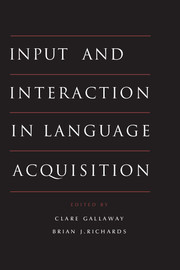Book contents
- Frontmatter
- Contents
- List of figures
- List of tables
- List of contributors
- Preface
- Introduction
- Part I General issues
- 1 The language of primary caregivers
- 2 The changing role of negative evidence in theories of language development
- 3 Crosslinguistic and crosscultural aspects of language addressed to children
- 4 Child-directed speech and influences on language acquisition: methodology and interpretation
- Part II Specific aspects of input and interaction
- Part III Types of language learner
- Conclusion
- References
- Author index
- Subject index
4 - Child-directed speech and influences on language acquisition: methodology and interpretation
Published online by Cambridge University Press: 05 June 2012
- Frontmatter
- Contents
- List of figures
- List of tables
- List of contributors
- Preface
- Introduction
- Part I General issues
- 1 The language of primary caregivers
- 2 The changing role of negative evidence in theories of language development
- 3 Crosslinguistic and crosscultural aspects of language addressed to children
- 4 Child-directed speech and influences on language acquisition: methodology and interpretation
- Part II Specific aspects of input and interaction
- Part III Types of language learner
- Conclusion
- References
- Author index
- Subject index
Summary
Introduction
A survey of publications about language acquisition written from a variety of perspectives reveals how far a common body of research into environmental influences can be used to support opposing theoretical perspectives. A newcomer to the field would surely be bewildered by the proliferation of statements which seem directly to contradict each other. On the one hand we learn that “these results … certainly suggest that ‘motherese’ is an effective teaching language” (Furrow and Nelson 1986, p. 175) and “Considerable evidence … supports the view that particular aspects of adulttalk to children may affect how children learn to talk” (Lieven 1984, p. 15); on the other hand we read “It does not follow that it [motherese] is causally involved in the acquisition process itself, still less that motherese or any specifically modified form of input is necessary to language acquisition” (Smith 1989, p. 146), or, from a recent book on second language learning, “The effects of babytalk on children's first language development have been impossible to prove” (Cook 1991, p. 98).
Snow, Perlmann, and Nathan (1987) ask what features of interaction with the child facilitate, or are necessary for, language acquisition. They conclude that, “This recurrent question has become, as more and more research is directed to it, not easier but more difficult to answer. Results of different studies are often contradictory” (Snow et al. 1987, p. 65). Just how contradictory is illustrated by Hardy-Brown (1983, table 1, p. 618).
- Type
- Chapter
- Information
- Input and Interaction in Language Acquisition , pp. 74 - 106Publisher: Cambridge University PressPrint publication year: 1994
- 32
- Cited by



